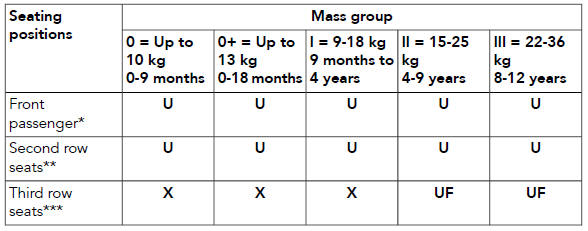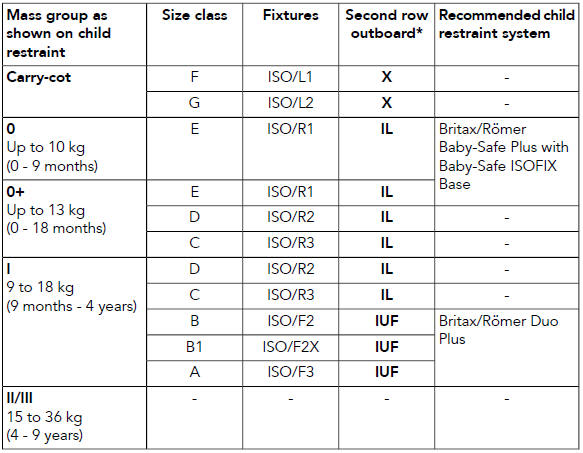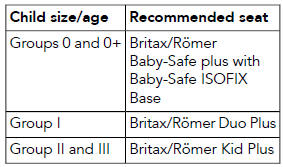Land Rover Discovery: Child seat positioning
Crash statistics show that children are safest when properly restrained in a child or infant restraint system that is secured in a rear seating position.
Seat belts (or suitable child restraints) should be used by all vehicle occupants, for every trip, no matter how short. Failure to do so will greatly increase the risk of death or serious injury in the event of an accident.
Information given within the table is correct at the time of going to press.
However, availability of child restraints may change. Please consult your Retailer/ Authorised Repairer for the latest recommendation.
Note: The information contained in the following tables may not be applicable to all countries. If you are in any doubt regarding the type and fitment of child seats, seek advice from a Retailer/ Authorised Repairer.
Note: Ages given are approximate. In case of doubt, the child's weight, not age, should be used when considering an appropriate child seat.
Note: The legislation which governs how and where children should be carried when travelling in a vehicle, is subject to change. It is the responsibility of the driver to comply with all regulations in force.

U = Suitable for universal category restraints, approved for this mass group.
X = Not suitable for the use of child restraints of this mass group.
UF = Suitable for universal forward-facing child restraints of this mass group.
* Always make sure the passenger airbag has been disabled before using a child restraint in this seating position.
The front passenger seat should be positioned fully rearward, the seat cushion to its highest position and the seatback adjusted to an upright position to support the child restraint.
** For vehicles fitted with sliding second row seats:
- Adjust the seatback to the upright position.
- Adjust the seat to the rear most position, unless the third row seats are occupied.
*** Adjust the second row seatback to the upright position and move the seat forward, to give sufficient clearance to allow fitment of the third row child restraint.
ISOFIX Child Seat Positioning

IUF = Suitable for ISOFIX forward child restraint systems of universal category, approved for use in the mass group.
IL = These ISOFIX child restraint systems are of the specific vehicle, restricted or semi-universal categories.
X = Not suitable for ISOFIX child restraint fitment in this mass group.
*For vehicles fitted with sliding second row seats:
- Adjust the seatback to the upright position.
- Adjust the seat to the rear most position, unless the third row seats are occupied.
Note: ISOFIX anchorages are provided for second row outer seating positions.
ISOFIX child restraints should be securely attached, following the manufacturer's instructions at these locations only.
RECOMMENDED CHILD SEATS 

